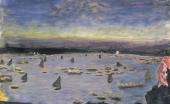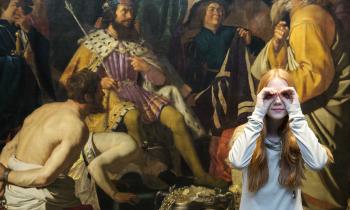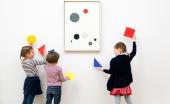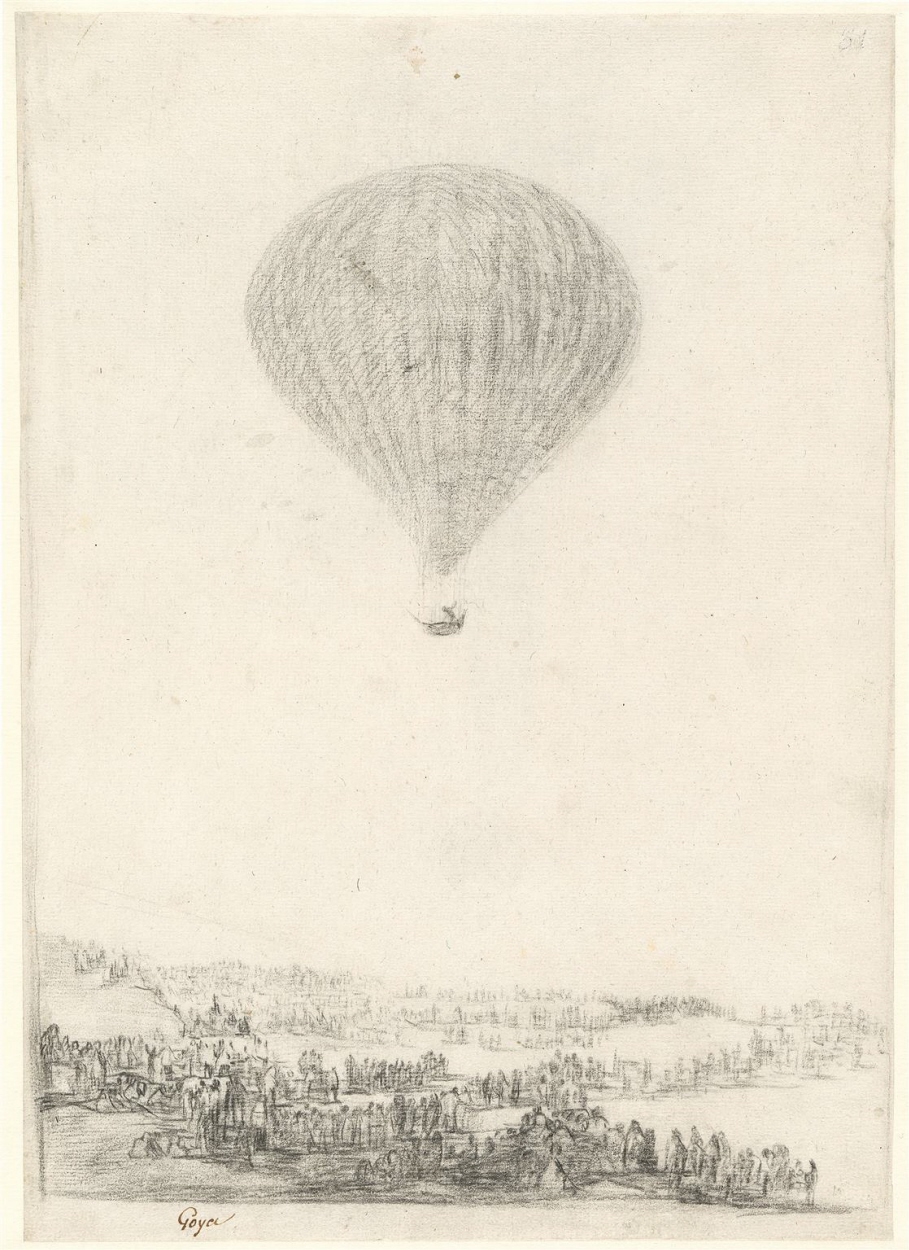Francisco José de Goya y Lucientes, zugeschrieben
Francisco José de Goya y Lucientes, zugeschrieben
In the catalogue of Francisco de Goya's work, the attribution of a group of drawings using only black pencil constitutes a pending problem that requires future study. When August Mayer published the Hamburg collection, he observed that
among the drawings attributed to Goya, there is not one about which we could say: this is undoubtedly by the master. The most possible of all is that of the Montgolfiere. It somehow recalls Romería de San Isidro. The drawing (black pencil) is very skillfully rendered, with considerable atmosphere and lightness. But, who knows whether it is by Antonio Carnicero, who painted a similar scene-in truth, somewhat dryer-in his painting number 644 at the Museo del Prado?[1]
Mayer's doubts had disappeared by 1923 when he listed it in his catalogue of Goya as by the master's hand with no mention at all of the possible attribution to Carnicero that had been based exclusively on subject matter with no stylistic considerations whatsoever. Since then, no one has questioned this attribution, which was also based on Echeverría's inventory of the Spanish drawings in the Hamburg collection. There, under numbers 30 and 31, we find: “30. By D. Francisco Goya, Chamber painter, and engraver. / 31. Idem." The latter number appears on the upper right corner of this drawing, in a similar hand. Moreover, the inscription of Goya's name, with the same ink used on that number, ratifies this attribution, although it is clearly not his signature.
Scholars such as Pierre Gassier[2] and Hanna Hohl[3] defended Goya's authorship, comparing the manner in which he drew the spectators observing the balloon's flight from the ground with the small, sketchily rendered human figures in other landscape drawings, such as Landscape with Buildings and Trees (Madrid, Museo Nacional del Prado, D 4279) in red chalk; The Pyramid (in the collection of the Marquis of Casa Torres)[4] in black pencil; and even the canvas of The Prairie of San Isidro (Madrid, Museo Nacional del Prado, P 750). Nevertheless, careful observation of certain technical details calls for a reconsideration of the pertinence of those comparisons, as this drawing is characterized by a smooth, homogeneous use of the pencil, which does not occur in drawings that are known to be by Goya, both in pencil and in red chalk. In those works, the addition of intense strokes and accents brings greater vibrancy to the compositions.
From a thematic standpoint, Hohl considered this drawing yet another indication of Goya's interest in transcending reality, in this case with an event he must have witnessed. In this subtle reading, Hohl separates the globe, a symbol of the human desire for freedom, from the social strictures that ground man to the earth. Notwithstanding this rather forced interpretation, it is true that balloon flights became a thrilling spectacle that garnered considerable interest in society and among artists of the time, fostering an active market for prints that publicized the main flights and their protagonists.[5] The most notable were those carried out in Madrid by Italian balloonist Vicente Lunardi in August 1792 and January 1793. The first began in the Buen Retiro gardens and reached the village of Daganzo, while the second took off from the Plaza de la Armería at the Royal Plaza and landed in the countryside near Pozuelo. There is no question that Goya could have seen them, as the first occurred before his illness, and he had already recovered before the second took place. That is not, however, sufficient evidence for establishing a causal relationship.
Another drawing with a similar subject, but more descriptive and made with pen and ink, was also attributed to Goya by Mayer, but like other drawings from the Casa Torres Collection, his authorship should be revised.
José Manuel Matilla
1 Mayer 1920, 134.
2 Gassier 1975, no. 335.
3 In Hofmann, Hollander, Serullaz et al. 1980, no. 218
4 Gassier 1975, no. 334.
5 An exhaustive summary of this subject appears in Vega 2010.
Details zu diesem Werk
Beschriftung
Provenienz
[José Atanasio Echeverría]; Julian Benjamin Williams, Seville (d. 1866); John Wetherell (?) (d. 1865); Horatio/Nathan Wetherell (?) (until 1874); Frederick William Cosens, London (from 1874 to 1890); Sotheby's, London, auction of the property of Frederick William Cosens (from November 11 to 21, 1890); Bernard Quaritch Ltd., London (from November 1890 to July 1891); acquired by the Hamburger Kunsthalle (July 14, 1891).
Bibliographie
W. Deiters, M. Föcking, A. Henning, E. Hipp, D. Klemm, V. Kobi, S. Pisot, J. Rauser, M. Schnieder, A. Stolzenburg, I. Tack, M. Weniger: Goya, Fragonard, Tiepolo. Die Freiheit der Malerei, hrsg. von Sandra Pisot, Ausst.-Kat. Hamburger Kunsthalle 2019, Abb.Frontipiz
Jens Hoffmann-Samland, with contributions by María Cruz de Carlos Varona, Gabriele Finaldi, José Manuel Matilla u. a.: The Spanish Gesture. Drawings from Murillo to Goya in the Hamburger Kunsthalle, Madrid 2014, S.170-171, Abb., 212, Nr.67
Idoia Murga Castro: Odilon Redon 1840 - 1916, Ausst.-Kat. Fundació MAPFRE und Musée d'Orsay 2012, Abb.S. 67
Jesusa Vega: Ciencia, arte e ilusión en la España ilustrada, hrsg. von Consejo Suprior de Investigaciones Cientificas, Madrid 2010, S.178
Petra Roettig, Annemarie Stefes, Andreas Stolzenburg: Von Dürer bis Goya. 100 Meisterzeichnungen aus dem Kupferstichkabinett der Hamburger Kunsthalle, Ausst.-Kat. Hamburger Kunsthalle 2001, S.208-209, Nr.99, Abb.
Leonore Stege: Kunst der Goethezeit aus den Sammlungen der Hamburger Kunsthalle, Ausst.-Kat. Hamburger Kunsthalle, Hamburg 1989, Nr.9
Werner Hofmann, Hans Hollander, Maurice Serullaz u. a.: Goya: Das Zeitalter der Revolutionen. Kunst um 1800, Ausst.-Kat. Hamburger Kunsthalle, Prestel 1980, Nr.218
Bernard Korzus und Burkhard Leismann: Leichter als Luft: Zur Geschichte der Ballonfahrt, Ausst.-Kat. Westfälisches Landesmuseum für Kunst und Kulturgeschichte, Landschaftsverband Westfalen-Lippe, Münster 1978, Nr.353
Pierre Gassier: Dessins de Goya, vol. 2: Etudes pour gravures et peintures, hrsg. von Office du Livre, Fribourg 1975, Nr.335
Pierre Gassier und Juliet Wilson: Vida y obra de Francisco de Goya, hrsg. von François Lachenal, Barcelona: Editorial Juventud (1st ed., Fribourg: Office du Livre, 1970) 1974, Nr.775
August L. Mayer: Francisco de Goya, München 1923, S.230, Nr.722a
Ausstellung von Zeichnungen Alter Meister aus den Sammlungen der Kunsthalle zu Hamburg, Ausst.-Kat. Kunstverein in Hamburg 1920, S.14, Nr.61
August Liebmann Mayer: La colección de dibujos españoles en el Museo de Hamburgo, in: Boletín de la Sociedad Española de Excursiones 18 Madrid 1920, , S.134
August Liebmann Mayer: Die Spanischen Handzeichnungen in der Hamburger Kunsthalle zu Hamburg, in: Zeitschrift für die bildenden Kunst 53, 29 1918, , S.118
Valeriano von Loga: Die graphischen Künste XXXI, Vienna 1908, S.7








